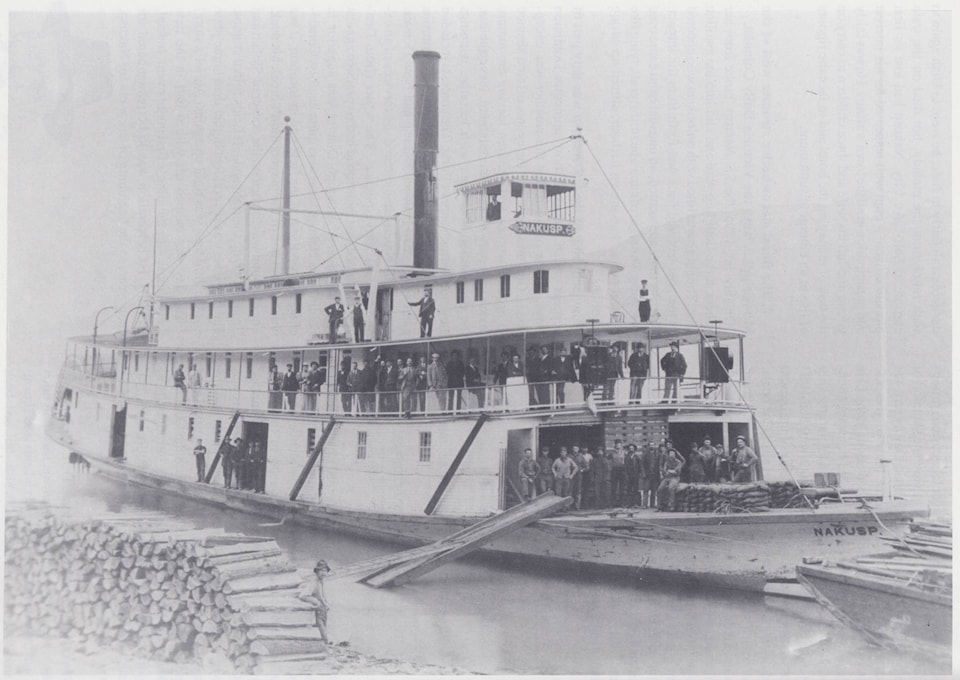Much has been said about the beauty of the Columbia River, and of how integral it was to those living in the Kootenays. From the very ecosystem of the area, to First Nations and their salmon catching, and to the steamers that travelled the waters, the river was and is a central piece of our community. But the river, as with any force of nature, had a temper.
May 1894 was an extraordinarily hot month, and with the heat came melted snow into the tributaries. The river flooded its banks, hitting the high water mark five weeks earlier than expected — and passing it quickly.
Nakusp was hit hard, as most of its industries and businesses were clustered around the waterfront. A manic pace of teardowns and moves commenced, as the machinery of the mill had to be moved, and the railroad tracks as well as the wharf secured. It came so fast, though, that much of the wharf came away — exacerbated by powerful winds.
Ranches were flooded, and even cords of wood stacked near the river were carried away. CPR bridges were threatened with destruction, and with many yards and sections of track underwater, rail transport was at a standstill. A family was even nearly stranded on Rothwell Point before they were saved by Jack Genelle and his tugboat.
If that wasn’t enough, nature was only getting started; as May rolled over to June, and the floods reached their peak, a windstorm brewed. Sporadically lit by flashes of lightning, wind and rain battered the town, sending the high waters into a deadly froth. The steamer Lytton had just finished unloading rails, and was preparing to head off — the storm caught her and sent her into shore, battering her against a tree. The ship suffered significant damage, including the loss of the smokestack. One can imagine how violent a storm must have been to knock the smokestack off a ship!
The aftermath of the flood showed just how much damage was done. The Kootenays relied on 190 miles of telegraph lines for communication; by the end of it all, only 20 miles were left standing. Anything along the waterfront was a loss, and shop owners decided to move their businesses to higher ground to prevent a repeat of the events.
Tref Nault, the man who led the first crew to clear Nakusp, lost 266 cords of firewood. Genelle and Co. lost 100,000 feet of dressed lumber, was put behind on supplying the railroad construction crews, and decided to rebuild their mill on pilings. Total damage to buildings and infrastructure in the area was estimated to be around $50,000. The flood had reached 40 feet above low water; the previous record was 31½.
The flood and ensuing storm were terrible disasters for a community like Nakusp; with telegraphs and rail transport down, and steamer service slowed to a crawl, the town was isolated in a way that seems impossible today. Imagine suddenly having no power, no cell service, and no way to get supplies because every major roadway was blocked! The townspeople had only themselves to rely on, and a lot of work to do; but work they did, and in time, the town was back to full strength.
The Columbia never saw another natural flood as dramatic as the one in 1894; with the dams in place, it never will again. Still, our area is perfectly capable of reminding us what nature can do. Windstorms that knock over trees and poles across the area, giving Hydro employees long days of repair jobs while getting badgered by impatient townsfolk. Avalanches that can take lives in an instant. Sudden dumps of snow that have people cursing themselves for not getting their winter tires put on earlier. Our town may be safe from the most disastrous weather and temperature extremes, but it never pays to forget our proximity to the natural world — or take it for granted.
